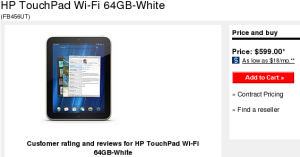HP announced recently they are going to manufacture another round of Touchpads to meet more demand, and limit one TP per customer. Best Buy has also been selling TPs with a limit of one per customer.
You can see in the Precentral Forums as well as the Palm Developer forums the frustration by the existing user base that many are not able to get their hands on hardware.
The limit per customer should help get TPs in to more hands without having to resort to the scalping market, though many folks wanted to buy a couple extras as gifts. One is better than none..
While the Touchpad continues to make headlines with the fire sale what hasn’t made any headlines is the desperate struggle many users are going through to try to get their hands on the HP Pre3 which was released in Europe mere days before the big HP announcement that they were getting out of hardware.
My own experience mimics that of many others, I put in an order to a UK reseller on the 20th whom appeared to have stock on hand. It took a few days to get past their security checks but I got past them, and then they went to go to their distributor to get stock (they apparently had none at the time), and their distributor told them they couldn’t have any stock, someone upstream (maybe HP, maybe another carrier the speculation runs wild) has blocked it. So the company refunded my money and that of many others who ordered. Unfortunately this took until Thursday of last week to find out I was not going to be getting Pre3s from this company.
So I set out on a quest to find Pre3s from someone else, every place I came across said no stock, there was talk about the Palm Eurostore selling Pre3s, BUT they only require both that your billing and shipping addresses are in Europe. No shipping to the US.
There is a UK reseller mobiles.co.uk which is requiring all orders be shipped to the UK. They accept US billing and shipping addresses but have canceled every order that had one after the order was placed.
There are people trying to order from expansys.fr over in France whom have a stock of AZERTY based Pre3s (I had never heard of AZERTY until then), but their shipping forms do not list U.S. as an option (I think people have tried anyways not sure of results). I have seen other stories of people in Asia getting their orders canceled by expansys.fr with the company directing those users to the Asian version of the site (which has no Pre3s of course). While it’s apparently not hard to change the keyboard layout in the phone itself, there is still the physical keyboard where the keys won’t be right once the mapping is changed. But users are willing to make the compromise in order to get their hands on the device (I would too if they’d ship to the US). I was about to order from them when I saw the billing address had no place to put a state. Only City, Country, and street address. Also no mention of U.S. shipping options, so it seemed pretty clear to me that they weren’t going to ship my order so I didn’t submit it.
So I began searching Ebay and came across another company KICK MOBILE over in the UK and I ordered a pair of Pre3s from them last Thursday morning. I emailed them later asking if they really did have stock because the last place did not, they said they are sold out *right now* but are 99.9% confident they will get 100 units the following day. The people/person at Kick Mobile has been very nice and friendly. Unfortunately Friday came and mostly went and Kick Mobile sent out an update saying they have not gotten stock yet but have confirmed their upstream supplier has 100 units set aside for them (out of 1500 units on hand), and they are still highly confident they will get them because Kick Mobiles is doing them a favor in buying a couple hundred older Blackberry phones to liquidate. They said they won’t know for certain until the end of this month or maybe the 1st or 2nd of September. The upstream supplier was waiting for authorization to release the units to the resellers.
I haven’t gotten an update directly yet (have not asked) but did see someone else post an update from them saying that Kick Mobiles no longer has confidence they will get that stock, though the final nail is not in the coffin yet (probably will be in the next 24 hours though).
What’s more frustrating is that Kick Mobile mentioned if I had placed the order a mere 24 hours earlier I would of gotten the phones. Getting the bad news back from the first reseller took too long!
I don’t blame any of the resellers they are all doing everything (or have done) they can to try to get the product to the desperate customers and have done a great job.
So yesterday I went on Ebay again and found a pair of Pre3s from what appears to be an end user who had two of them, and I immediately hit the buy it now button to buy one. I’m normally not one who likes to use auction sites I don’t know why I just don’t feel comfortable doing it but at the moment if I want a Pre3 (and I want one as you can clearly see) I have little choice at this point, it seems as time goes on there are fewer and fewer available, even though there is good information that says there are at least hundreds to thousands being held up in warehouses with an uncertain future. You can probably bet there are hundreds to thousands of AT&T and Verizon branded Pre3s as well which people speculate may just be outright destroyed rather than sold.
With each attempt to buy a Pre3 the unit price has gone up by roughly $125. There’s one report of someone paying over $900 for one.
There have been rumors of a fire sale of Pre3s as well but so far very few have been able to get them at those prices, even the official Palm Eurostore says they were not able to resell at those prices and in fact is unable to get more stock and is canceling all outstanding orders and not accepting new orders. Not a good sign. Contrary to initial beliefs the Eurostore is not directly affiliated with HP or Palm but is a 3rd party reseller like most others. From their web site
Update Wed 31st Aug 15:00 :
From the contacts we initiated since last Friday ;
– We have cancelled and refunded all orders where we received notification to cancel.
– We have shipped all orders for those people we had contacted and who accepted the order for a single unit at the standard/agreed price.
– We are still awaiting response from some of the people we contacted
We are now going to set a deadline of midday (BST) on Thursday 1st Sep. A final reminder email has gone out to these people. We will have no option but to cancel those orders after that point if we have not heard back from them.
The European Pre3 only works on one of the two AT&T 3G frequencies, so will be crippled to some degree(mainly when used in doors), by contrast I read that the way T-mobile uses their frequencies the Pre3 would have no 3G coverage at all. T-mobile apparently uses one frequency for upstream and one for downstream, AT&T has both frequencies available for up and down.
I’ll take what I can get though, assuming I can get the Pre3. I got a Pre2 in yesterday (can’t use it yet because I don’t have a SIM card). Was supposed to get a Veer (with AT&T SIM) yesterday, but fedex screwed me on the delivery claiming my address was wrong and before I could pick the package up at the local facility shipped it back to AT&T. I have another Fedex package coming from HP today with a Touchpad and some accessories in it, will see if they screw up again. I’ve recieved a lot of UPS and USPS packages at my address so I know it’s right, it is a new address, the building has only existed for about 1.5 years but hard to believe Fedex hasn’t delivered a package here before, there’s a couple hundred people living here.
While the initial reviews of the Pre3 are very positive at least from the WebOS community(which is biased of course), they are not suitable devices for the general public in the U.S. as you will have to jump through hoops and stuff to use them due to the frequency differences and general lack of support. But for more hard core technical users it’s clear it’s by far the best phone to come out of Palm since the first Pre launched back in 2009.
In case your wondering why I have been trying so hard to get my hands on a Pre 3. Well part of it as I have mentioned in the past is, for several different personal reasons (won’t elaborate again here), I won’t really go near a Android, iOS or Windows mobile device for myself at least. The Pre2 and Pre3 will keep me on a platform I like for a while to come until I need to make a decision about where to go at that point. I’ve been using a feature phone from Sanyo for the past 8 months while I waited for the Pre3 to be released. It’s an OK phone, I like that I don’t have to charge it often, though it’s not as nice as the Sanyo phones I used to have, the software is quite different, and in general not as good. It may be because the phone might just be Sanyo in name since they were bought by Kyocera (the phone itself says Sanyo by Kyrocera) Though I guess one thing I will be able to finally test without being too paranoid is how rugged this rugged phone really is, your supposed to be able to completely submerge it in water and have it be OK. I’ll finally test that out!
Meanwhile my order for 4 Touchpad 16GBs which was accepted by HP’s systems on August 21st at 2AM (26 hours before their cutoff period for canceling orders) is still pending shipment, I assume they are out of stock now. The order status page says it is in an “Admin” state. My 2nd order was processed before my first which I thought was unusual. My 2nd order is the 5th Touchpad with accessories, in order to secure a discount on accessories I had to buy another TP. I was in such a hurry to buy the original Touchpads I did not pay attention to accessories or discounts on the 21st as I was busy fighting server errors on HP’s side.
My original Palm Pre, which has been disconnected from the Sprint network for 8 months did something unusual on Monday – it showed I had a new voice mail. I checked my normal Sprint phone it too said I had a voice mail. I would not of expected the Pre to show that (it never has before). Just because I was curious I tried to check the voice mail on the Pre and got a message from Sprint saying my account could not be verified. So clearly the phone wasn’t authorized to operate on Sprint anymore, must’ve been some sort of temporary hole opened in the Sprint network which allowed the phone to log in for a moment and detect the new voice mail.
I only wish management at HP cared enough to handle this whole situation better in the first place. I do feel sorry for the entire WebOS division (hardware+software), including the leadership who were just as blindsided by this as everyone else. I can’t imagine the stress the leadership is under to try to maintain morale at this point.
Over 2,000 words for this post, not bad.



